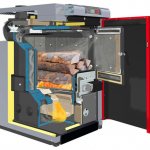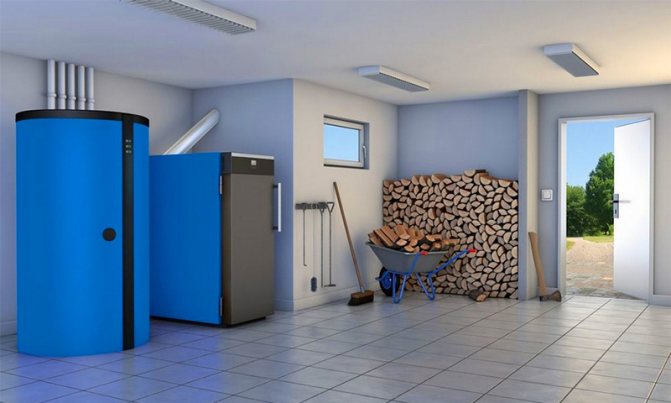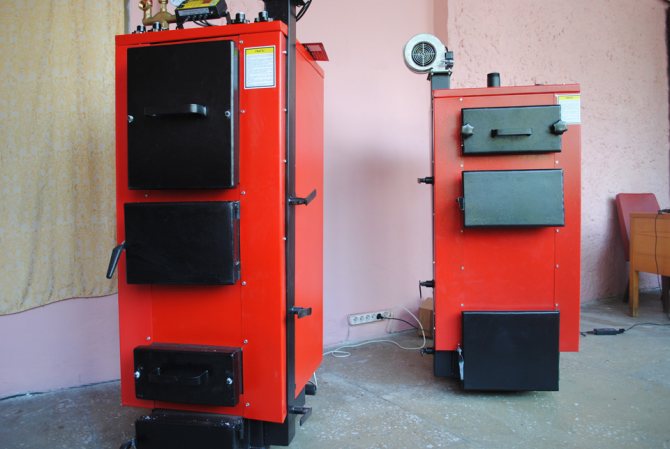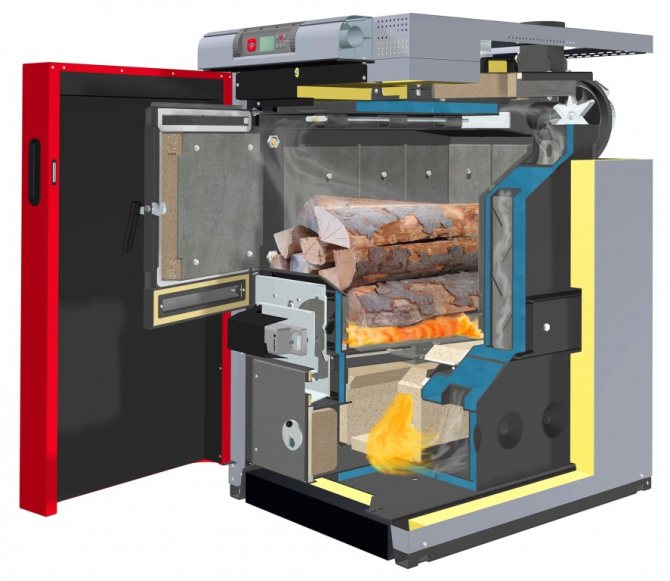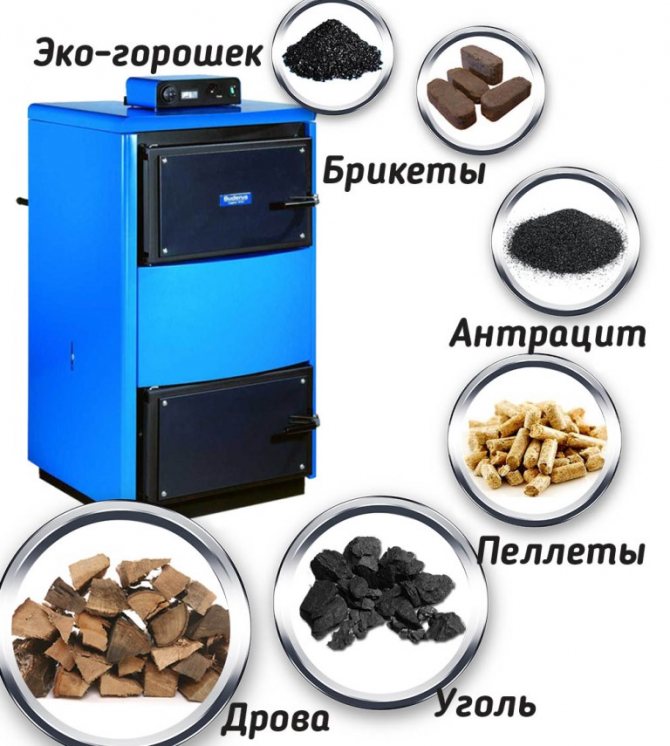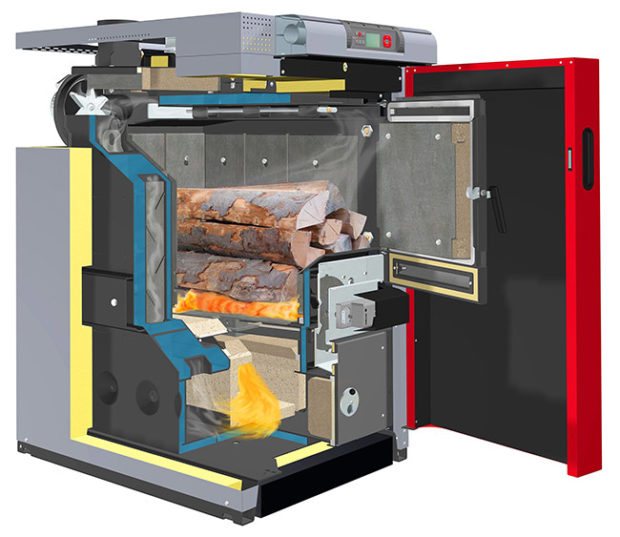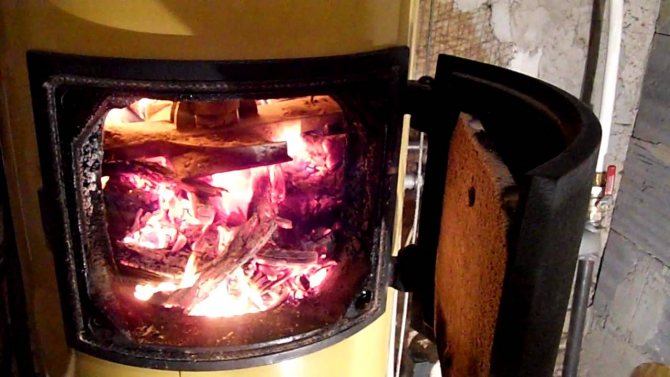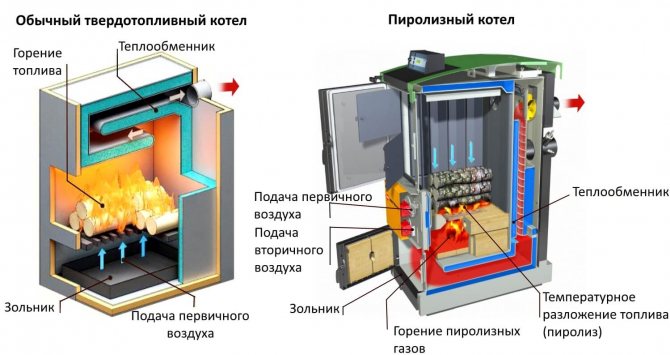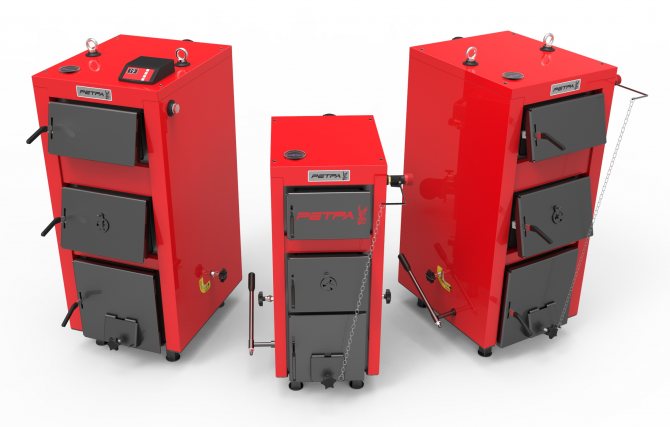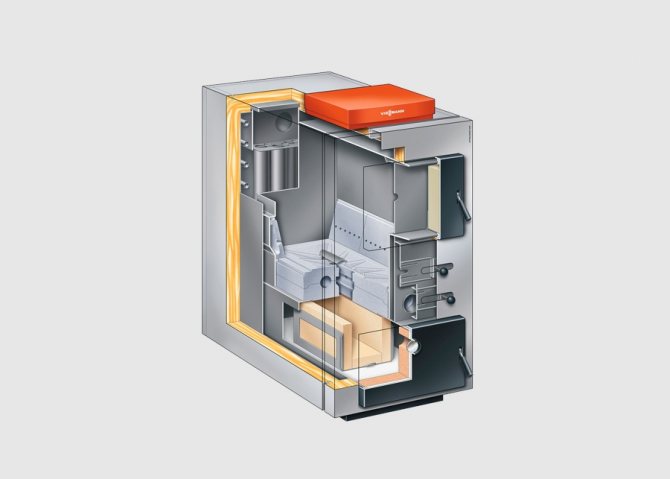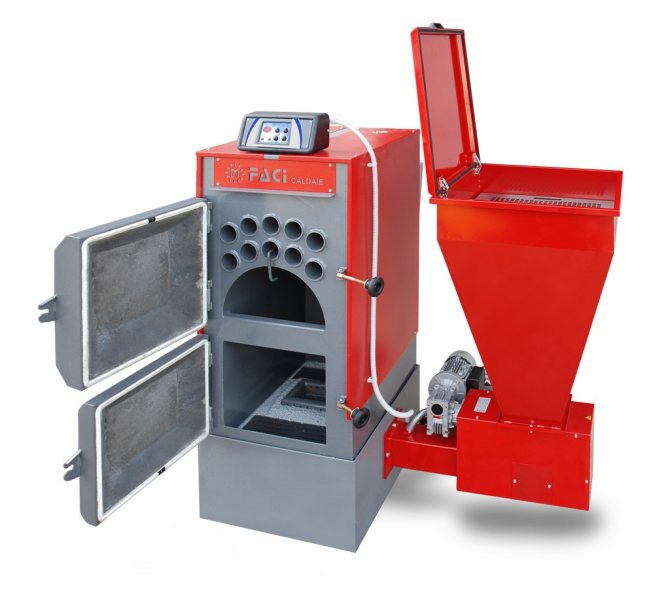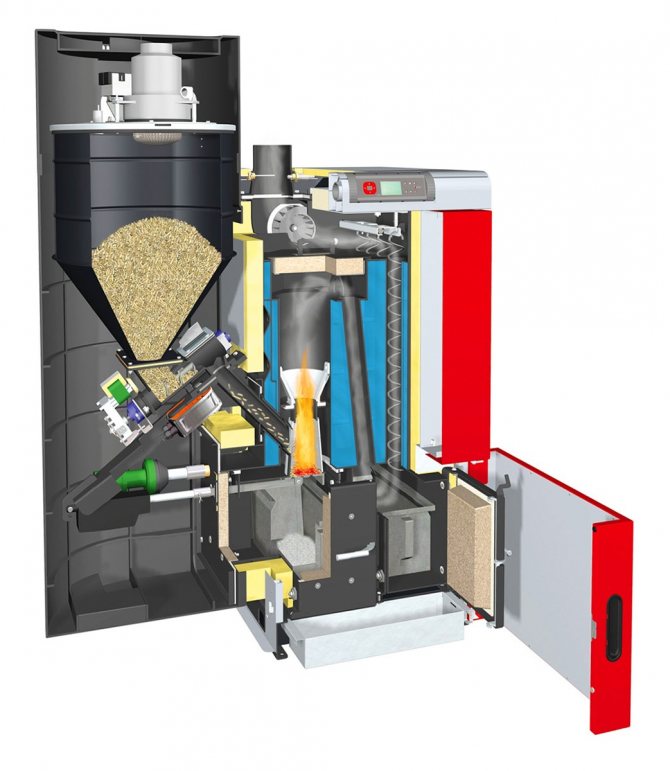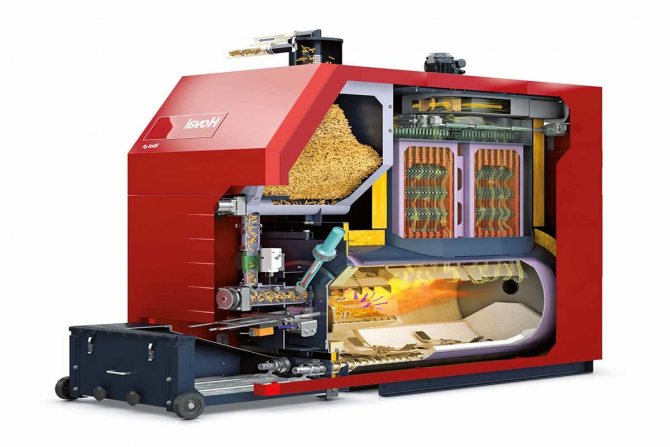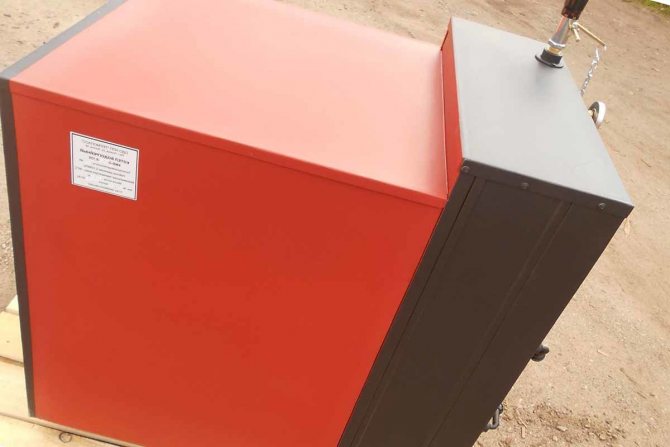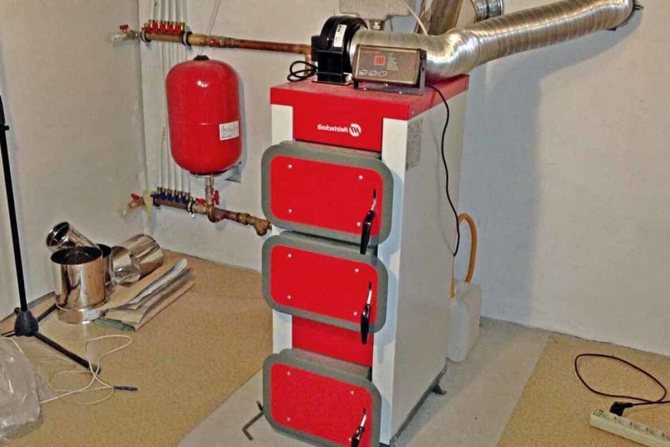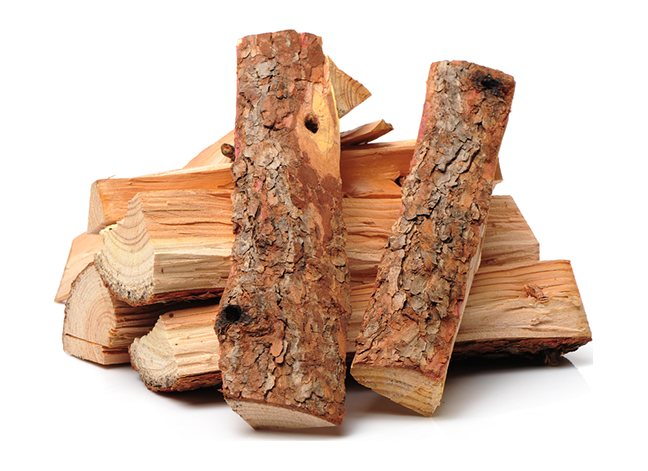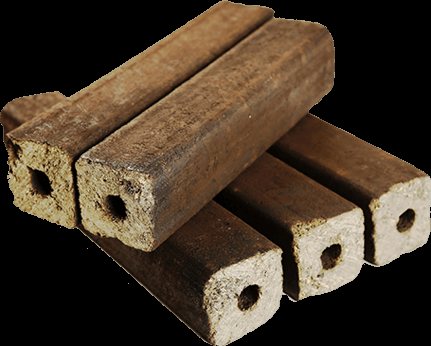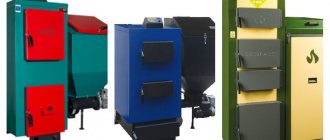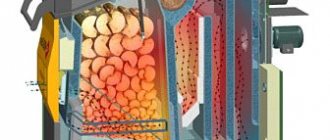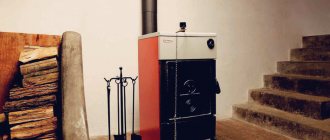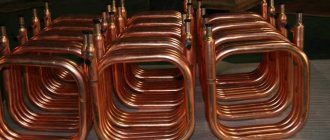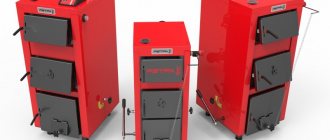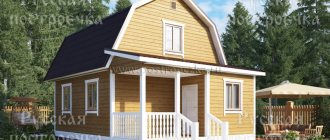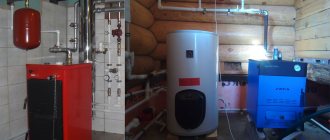# 1. Briefly about the principles of work
It would seem that difficult in a solid fuel boiler? I threw wood or coal into the furnace, they burned out, heated the water, and the house was filled with warmth. In general, everything is true, but the principle of operation of the device is somewhat more complicated. In the design of a modern solid fuel boiler, the following main elements can be distinguished:
- firebox;
- coolant circulation system;
- smoke removal system;
- safety system;
- heat storage system.

AT firebox fuel is supplied and burned to obtain heat. This is the classic version. There are pyrolysis boilers in which solid fuel (wood) smolders, releasing gas, which then burns, providing heat. At the same time, the efficiency somewhat increases, but we will deal with the peculiarities of the operation of classic and pyrolysis boilers later.
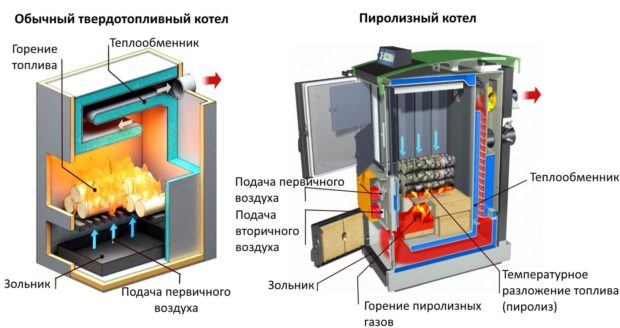

The firebox is a large container with double walls, between which there is coolant... In most cases, this is water, less often an antifreeze liquid or a mixture of water and antifreeze is used. The coolant receives heat from the burnt fuel, circulates through pipes and radiators, heating the air in the house. Cooling down, the water returns to the boiler again and everything is repeated. Often special pumps are used to improve circulation.
When fuel is burned, not only heat is generated, but also gases that must be removed. The system is intended for this. smoke removal... The chimney removes gases from the boiler to the street, sometimes a forced ventilation system is used to increase the efficiency of this process.
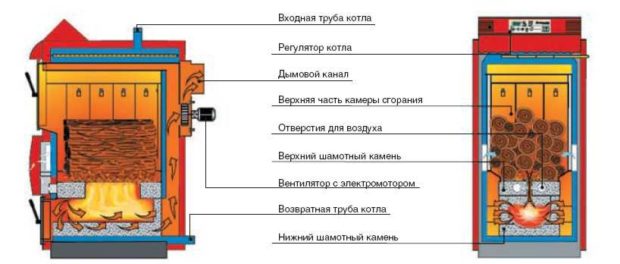

The most great dangerthat can happen when a solid fuel boiler is running is overheating of the coolant... The water may already be sufficiently heated and the boiler will continue to generate heat. If the water boils, the heating system may not be able to withstand it, especially if the house has metal-plastic pipes that are sufficiently sensitive to high temperatures. It is almost impossible to stop the combustion of firewood or coal - all that remains is to reduce the intensity, and so that the overheated coolant does not get into the system, they use cooling heat exchanger... It receives cold water from the water supply system, but in case of a water cutoff, it is better to always have a sufficient supply of it.
The cooling heat exchanger can be built into the boiler or between the boiler and the rest of the heating system. It can only be built into the structure of a steel boiler. It works in one of two possible ways:
- first option - cooling of the heated coolantwhich passes through a cooling heat exchanger. Cold water is supplied to the cooling heat exchanger through a thermal valve, which opens when the coolant temperature reaches + 950C. The process continues until the coolant cools down to a safe temperature;
- the second option provides for the presence shut-off valve... If the water temperature rises to critical values, the valve does not allow it to flow into the pipes. Cold water is supplied to the heat supply system from the water supply system, and the overheated coolant is drained into the sewer. True, the water pressure should be sufficient, and its composition should not contain an increased amount of salts, which will provoke the formation of scale.
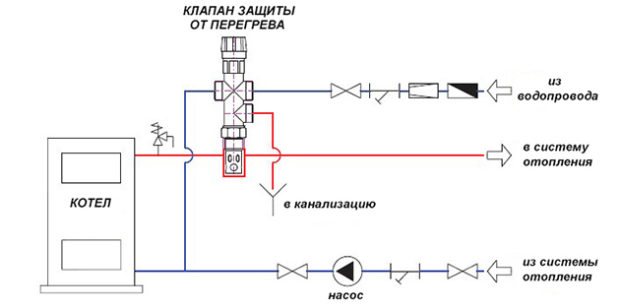

Dumping heated water into the sewer is not very smart and economical, therefore, it is better to supplement the design of a solid fuel boiler storage tank... This is a buffer between the boiler and the rest of the heating system, thanks to which a number of important functions:
- warm water accumulation for its further use, and this is fuel economy, comfort, stability in maintaining the temperature and a decrease in the number of trips to the firebox for tossing fuel;
- protection against accidents... In the tank, overheated water is mixed with warm water;
- the ability to use boilers of different types... The storage tank will be common for a solid fuel and, for example, a gas or electric boiler, will allow you to simply organize a single heat supply system at home and insure yourself with several heat sources.

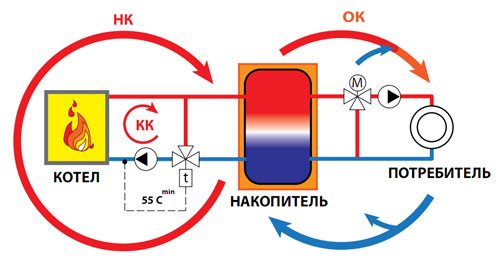
Heat accumulators are made of cast iron or steel and receive powerful thermal insulation. Buffer volume, first of all, depends on the power of the boiler: for each 1 kW, it is necessary to provide 25 liters of tank volume. The quality of this element of the heating system must be of the highest, therefore it is better to trust the products of well-known manufacturers. The online store https://www.duim24.ru/ presents heat accumulators only from trusted companies, the assortment includes tanks of different volumes and materials of manufacture.
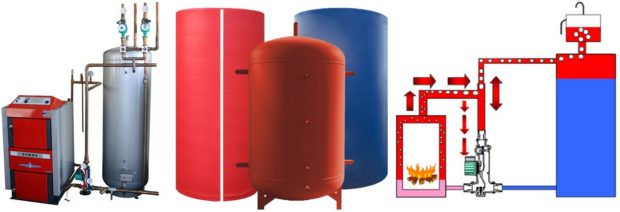

The principle of operation and features of a solid fuel boiler
Before we start comparing the manufacturers and models of such units, let's figure out what kind of installation it is? This is a special device that is designed to burn a certain type of solid fuel in order to heat the coolant (for example, water), which, circulating through the pipes inside the house, will heat it, giving off the accumulated heat. In theory, a solid fuel boiler is an ordinary stove with a special container with water. A pipe circuit is connected to this storage tank, through which the heated liquid is sent on a journey around the house.
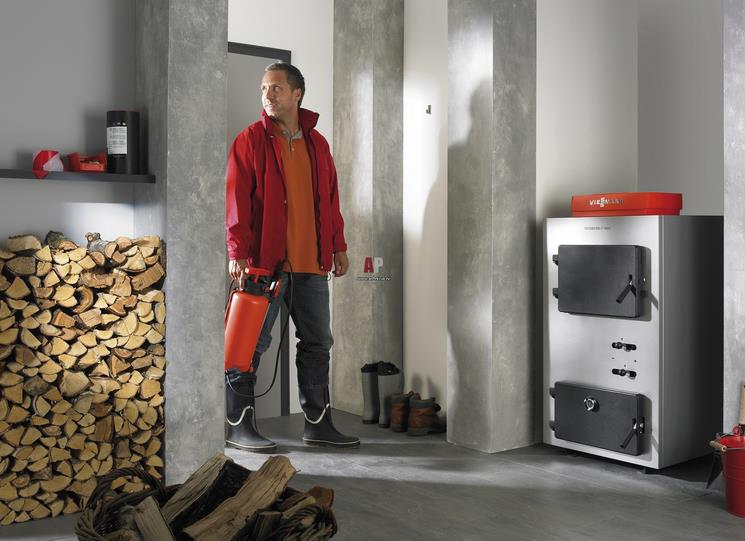

Solid fuel boiler in the house
Fuel is supplied to such a unit manually, although in industrial plants this process is automated. Various solid (most often natural) materials are used as fuel for the boiler - usually coal, peat, wood, fuel pellets, coke, wood chips, etc.
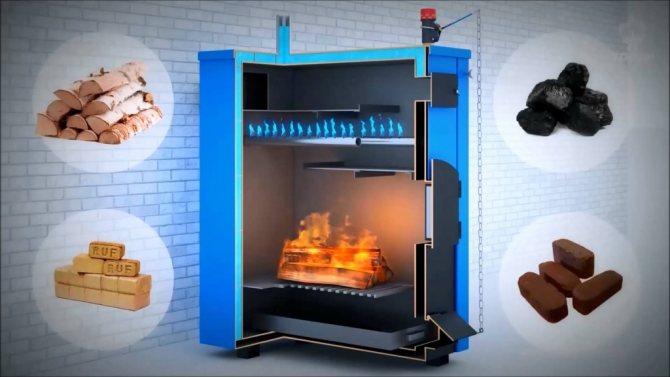

How to choose a solid fuel boiler for a private house
On a note! Thanks to solid fuel boilers, it is possible to organize the process of recycling woodworking waste - chips and sawdust. Thus, the units perform not only a heating function. Their use is justified in those areas where the woodworking industry is widely developed.


Steel solid fuel boiler
Typically, solid fuel boilers are used in cottages, as well as for heating small workshop premises. Some owners of private houses do not even bother buying an installation in a store, since this device can be made by hand, because its design is extremely simple.
- Fuel is manually loaded into the combustion chamber through the combustion door and ignited.
- Water is heated in the lower part of the heating circuit - the so-called heat exchanger made of metal.
- Through a special pump or in the process of natural circulation, heated water enters the pipe system and flows through them.
- In the process of circulation, the water gives off the heat accumulated in the heat exchanger.
- The liquid is returned to the boiler, already cooled, where it is heated again, and the process is repeated again.
- The emissions (smoke) resulting from the combustion of the fuel are discharged to the outside through the chimney.


Solid fuel boiler device
Now solid fuel boilers are sold in many hardware stores, these devices are reliable, unpretentious, easy to maintain, and therefore in demand. Plants come in various sizes and shapes - square, rectangular, round. They can also differ from each other in power and other parameters.
You may be interested in the information-oil boiler
To avoid overheating (and such a phenomenon takes place), the boiler can be equipped with a protection system against exceeding the permissible temperatures.For example, cold water can be added to the heat exchanger at the signal of a special temperature sensor. Also, at the outlet of the installation, a buffer tank can be installed, where the liquid of excessively high temperatures will mix with the cold one - thus, the system is cooled in this case.
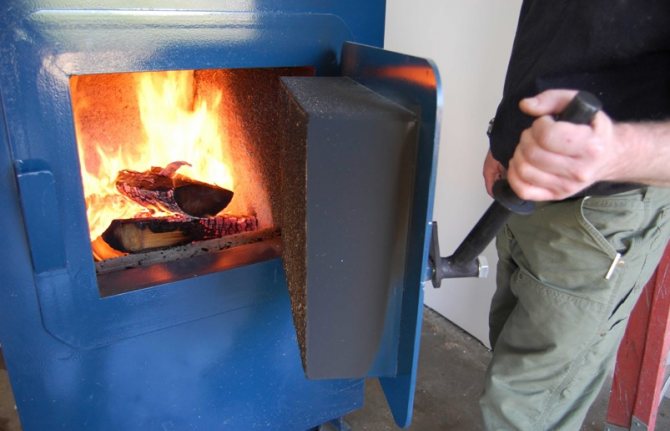

Solid fuel boiler
# 2. Types of solid fuel boilers according to the principle of operation
With a similar general scheme of the device, different types of solid fuel boilers have some design nuances. The entire existing assortment can be divided into the following types:
- classic or traditional boilers;
- pyrolysis or gas generating boilers;
- long burning boilers;
- pellet boilers.
Classic solid fuel boilers
Such boilers are a lot like ordinary stoves. The heat is obtained here as a result flaming fuel... As a rule, firewood or coal is used as the latter. Fuel is supplied through one door, and through the other - the boiler is cleaned of ash and other products of incomplete combustion. Traditional boilers can have both cast iron and steel heat exchangers, usually used in natural circulation systems.
Although the efficiency of this type of device is not the highest, they are valued for reliability, because the design of the boiler has a minimum of electronic elements that can fail. The only automation element is a temperature controller, but it also works on a mechanical principle. Classic boilers are durable and rarely require repairs.
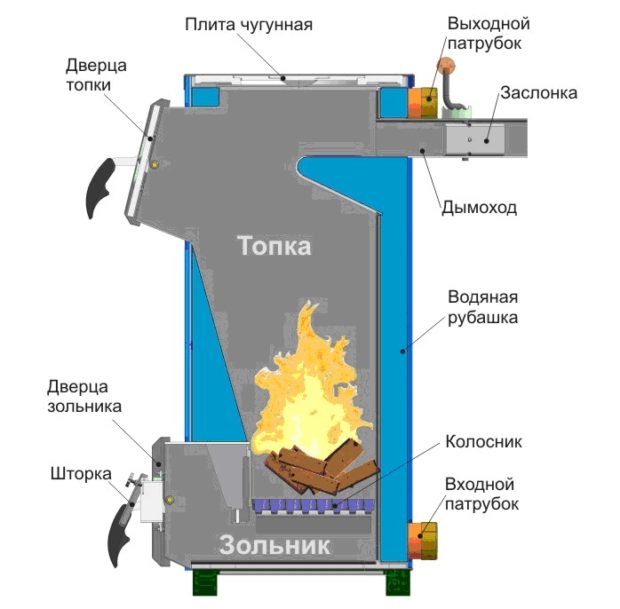

Pyrolysis boilers
Pyrolysis (gas generating) boilers are somewhat more complicated. Their design contains two combustion chambers... Solid fuel (firewood) is put in the first, at high temperature and oxygen deficiency occurs pyrolysis process with the release of pyrolysis gas. It goes into the second chamber, where it burns and gives off heat to the coolant. Only charcoal remains from the firewood.
The combustion temperature of pyrolysis gas is higher than that of firewood, which increases the boiler efficiency by up to 90%. If we take into account the fact that the process of wood decay is slower than its combustion, then we can talk about another advantage - one fuel fill is enough for 10-13 hours (for classic boilers, this figure is 5-7 hours). The fuel used is hardwood and low moisture content (no more than 20%).


Long burning boilers
This type of boilers resembles pyrolysis boilers in many ways, but differs in some technical features. Solid fuel smolders in the first chamber, forms gases that burn out in the second furnace. In this case, only the upper part of the fuel is involved in the process of smoldering and combustion. Due to this, it has to be loaded less often, and the efficiency increases. One load of firewood is enough for the boiler to work two days... The main disadvantage is the high cost of the equipment.
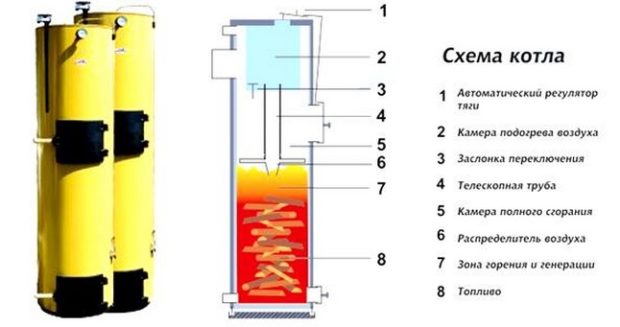

Pellet boilers
They are also often referred to as automatic boilers. According to the principle of operation, they differ little from traditional ones, but besides the firebox, they have bunker for storing a stock of fuel. This means that it will not be necessary to often come up and pour fuel into the furnace manually - everything will be done by automatic equipment. Approximately 7 days... In addition, such a system can be very precisely adjusted for yourself. Fuel is considered one of the most environmentally friendly at the moment. Pellets are granules that are produced from wood waste (sawdust, shavings, etc.). The efficiency of such systems is 91-95%, the only drawback is the high price of boilers.
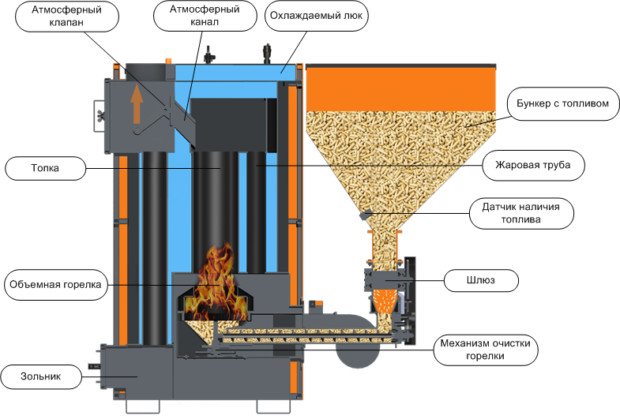

How to choose?
Before dwelling on a specific model, define a few points for yourself:
- Future type of fuel: depending on the region, living conditions and other factors, determine the best option, because somewhere the most profitable fuel may be peat, and somewhere - firewood.There are also combined models that allow you to be heated with wood at one time, and with electricity at another.
- Unit power: it is generally accepted that 1 kW is the required power of the device for heating 10 m in a room with high-quality insulation and a ceiling height of up to 3 m.However, this indicator is averaged, because in the calculations it is also worth taking into account the area and quality of glazing, the number of doors, the presence basement or attic, type of insulation in the walls, etc.
- Decide on the number of circuits in the boiler, because you may need not only heating the house, but also the supply of hot water for domestic needs. Then you can install a double-circuit boiler or a single-circuit solid fuel and connect an indirect heating boiler to it.
- Consider the frequency of use: there is a difference whether the house will be used for permanent residence or it will be temporary housing such as a summer residence.
- The system material is steel or cast iron. Steel options are pleasing with low cost, optimal dimensions, low weight and their maintainability. However, such models are susceptible to corrosion, and their service life is only 20-25 years. Cast iron units serve their owners for 30-35 years, but they are much more expensive and heavier than steel counterparts, which means that there will be more problems with transportation and installation. In addition, cast iron devices run the risk of getting a thermal shock, because cast iron itself is quite fragile and does not tolerate sudden temperature changes.
No. 3. Heat exchanger material
There are few options. Heat exchangers can be:
- steel;
- cast iron.
It is difficult to say unequivocally which solid fuel boiler is better to choose - it all depends on the budget, operating conditions and personal requirements. Manufacturers produce both those and those boilers.
Cast iron heat exchangers have the following advantages:
- they are going to from separate sections, therefore, their transportation and installation is easier. Moreover, if one of the sections is damaged, can be replaced, so durability such boilers at a height - up to 20 years or more;
- cast iron during operation is covered with a film of iron oxide. This is a dry rust that hardly progresses, protecting the rest of the material from negative effects. Cast iron more resistant to corrosion, therefore, the heat exchanger will have to be cleaned less often;
- cast iron keeps warm longer, that's a plus. The downside is that it warms up more slowly.
Among cons high weight, higher than steel, brittleness, and low resistance to thermal shock. With a sharp change in temperature, the cast-iron heat exchanger can easily crack, so avoid getting cold water into the still-hot heat exchanger.
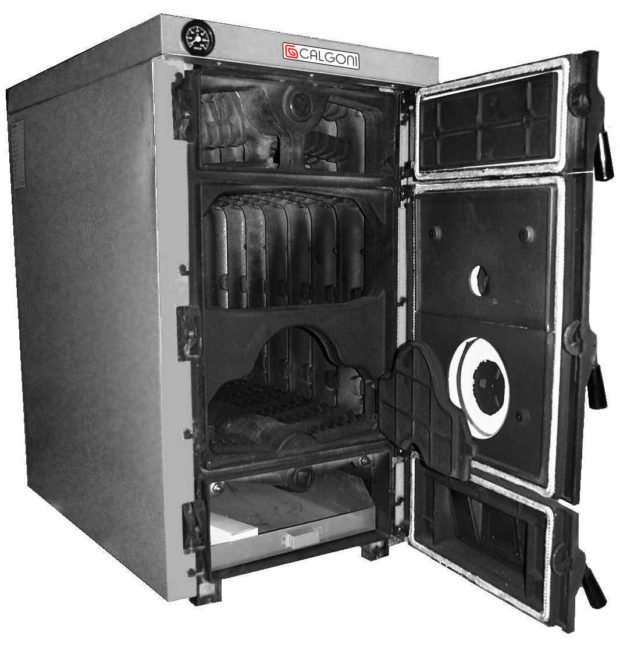

The advantages of a steel heat exchanger include:
- higher strength, and since such a heat exchanger is cooked in the factory and comes out in one piece, it becomes possible to manufacture combustion chambers of complex configurations, due to which the efficiency increases;
- high resistance to sudden temperature changes... Boilers with such heat exchangers, as a rule, receive more advanced automation, since the temperature can be controlled freely without fear of damaging the structure;
- not as high weight as cast iron;
- faster heating, but also faster cooling.
On the other hand, steel is more prone to development corrosion processes... Despite the resistance to temperature extremes, with frequent such fluctuations, cracks may appear at the weld points. In which case it will be impossible to repair the steel boiler - you will have to buy a new one, therefore, the durability of such structures is lower.
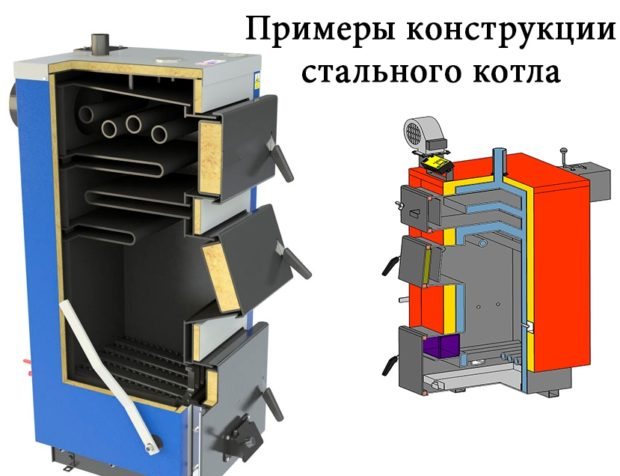

No. 4. Traction and energy consumption
Solid fuel boilers can be divided into two types:
- non-volatile natural draft... They do without special pumps, so they do not consume electricity. Classic boilers and some long-burning boilers function in a similar design.Well suited for areas with frequent power outages, can be used as a backup heat source;
- volatile with additional thrust... The design provides for a fan that helps air flow into the combustion chamber. Most long-burning boilers, pellet and pyrolysis boilers are produced in this design. Some settings can be made using the control panel.

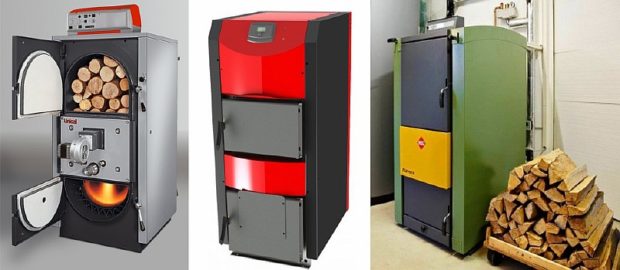
Burning method
Another important point when choosing a solid fuel boiler is the method of fuel combustion, the cost of the boiler and the efficiency of the heating system as a whole depend on this.
| Natural draft boilers have the simplest design: the air necessary to maintain combustion enters the furnace in a natural way, without the use of additional equipment. The advantages of boilers of this type are low cost and the ability to use any type of solid fuel as a source of energy. |
| Forced draft boilers more effective than natural. Air intake into the furnace is carried out using a special blower, which makes it possible to control the temperature regime by adjusting the blowing power. Due to the faster air circulation, the combustion products are removed through the chimney at a lower height than with natural draft. |
| Principle of operation pyrolysis (gas generating) boilers consists in dividing the combustion process into several stages. In the receiving chamber, the wood is heated to the temperature of the release of pyrolysis gas, which, when mixed with oxygen, burns with maximum heat transfer. |
| Long burning boilers represent the most efficient equipment among solid fuel heaters. Due to the successful implementation of the principle of upper combustion, such a boiler provides an even release of heat energy and a longer combustion time than other boilers. |
No. 5. Number of contours
Single-circuit boilers responsible only for the heating system. There is also double-circuit boilers, which allow you to provide a hot water supply system for a private house. This is very convenient, but when calculating the required power, you should definitely take this feature into account. In addition, there are boilers equipped with hob.
Pay attention to the fact that solid fuel boilers are installed on the floor - there are no wall-mounted models.


No. 6. Calculation of the power of a solid fuel boiler
One of the main indicators that you should first of all pay attention to when choosing a solid fuel boiler is its power, on which it depends on what area it can provide with heat. One should proceed precisely from the area of the heated room. You can use the generally accepted rule: for every 10 m2 of area, 1 kW of boiler power is needed. This is subject to normal thermal insulation and a ceiling height of no more than 3 m.
It turns out that a 15 kW boiler will be enough to heat a house with an area of 150 m2. Even at an external temperature of -360C, it will maintain the temperature in the house + 180C. With insufficient thermal insulation at home, as well as in a harsh climate, it is better to take a boiler with a small power reserve.
If the boiler is to be used in a hot water supply system, then this must be taken into account when calculating the power of the heat exchanger. Experts say that in order to ensure comfort in the house, the power of a double-circuit boiler in any case should not be lower than 24 kW. It is better to entrust more accurate calculations to professionals who will take into account all the features of a particular house and heating system.


Factors for choosing a solid fuel boiler
When choosing a solid fuel boiler to heat your home, in addition to the fuel used, a number of parameters and characteristics should be taken into account. Let's list them.
- Heated building area. Key parameter. The required boiler power, and in some cases the choice of fuel, directly depends on its value.
- The height of the ceilings in the house. It is also important for determining power.
- Indicators of heat loss in the room. They are influenced by the materials and thickness of the walls, the number and size of windows, doorways.
- Extremely low winter temperatures in the region. The coldest days of winter are taken into account and, based on extreme temperatures below zero, the model and power of the device are selected.
You can entrust the calculation of the required boiler power to a specialist, or make the calculations yourself. Calculations are made with the calculation of 1 kW of power per 10m2 of house area with a ceiling height of 3 m.
Solid fuel boilers also differ in the type of fuel loading.
- Automatic feeding. Here, in addition to the boiler itself, there is a bunker. It is loaded with fuel for long, uninterrupted operation. One full load of such a bunker is usually enough for 3-5 days. It is rational to install such a system in a large house or enterprise. In addition to the absence of the need for frequent manual loading, the advantages of this technology are material savings in the future and constant power throughout the entire operation time.
- Manual loading. A good solid fuel boiler, but you need to supply fuel in it yourself. Such systems can work on all of the listed fuel options, and the smaller dimensions and low cost of such a boiler in comparison with an automated one, makes it the best solid fuel boiler for a private house with a small and medium area.
In addition to the characteristics described, the materials from which the boiler is made are also important, since steel that is too thin is not durable and can give slack after a few years. In addition, heavy and thick-walled boilers give heat transfer for a longer time and have a high efficiency, although they heat up longer, so the presence of a "thermos" must also be taken into account.
No. 7. Fuel type
You can throw into the firebox of a solid fuel boiler firewood, coal, pellets and sawdust... It is a mistake to believe that the power of the boiler will remain unchanged, no matter what fuel is used. Many models of boilers can work with different types of fuel, but at the same time, the maximum power will be achieved only when using the fuel that the manufacturer indicated as the main one. When using less high-calorie fuel, the power will drop by 25-30%, and if it is too wet, then the power drop can be up to 40%.
Average parameters of heat transfer for different types of fuel:
- firewood - 2500 kcal / kg. Logs of wood are usually 25-30 cm long and can be sawn or chopped. It is important that the wood is dry;
- anthracite coal - 7400 kcal / kg;
- hard coal - 7000 kcal / kg;
- brown coal - 3500 kcal / kg;
- pellets - 4500 kcal / kg.


Solid fuels
When choosing a solid fuel boiler, you must focus on the type of fuel that you will use. The economic benefit from using a particular type of energy carrier can vary significantly from region to region. Modern boilers run on the following fuels:
|
| ||
| Solid wood breeds | Coal different factions | Granular waste production (pellets) | Fuel briquettes |
Universal solid fuel boilers operate on several of the above types of fuel at once.
No. 8. Combustion chamber volume
The larger the volume of the combustion chamber, the more fuel you can load, and the less often you run to the firebox and throw in a new portion. In the characteristics of the boiler, it is customary to indicate such an indicator as the ratio of the volume of fuel loading to the power of the boiler, measured in l / kW.Since a steel boiler with the same power as a cast iron boiler will have slightly more compact parameters, for it this ratio is 1.6-2.6 l / kW. For cast iron boilers - 1.1-1.4 l / kW. The higher this indicator, the less often you will have to run to the boiler.
For boilers with top loading fuel the useful volume is larger, and in this case the fuel is distributed more evenly. With front loading, especially when it comes to a cast iron multi-section heat exchanger, some effort will be required to evenly distribute the fuel.
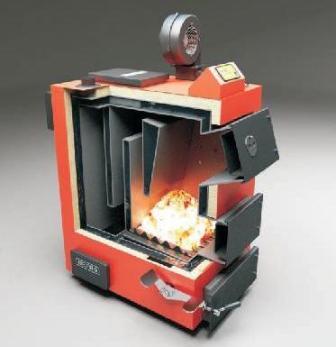

No. 9. What else to consider when choosing a solid fuel boiler?
Obviously, even before buying a boiler, it is worth deciding whether the boiler will be the main source of heat or a backup one. In the latter case, it will be necessary to install an expansion tank or heat accumulator - it is easier to do this right away than to upgrade the existing system later.
If in the future there is an opportunity switch to gaseous fuel, when choosing, you should pay attention to the possibility of transforming the boiler. Many traditional boilers can switch to gas by installing an inflatable burner. It is convenient, but it should be borne in mind that the efficiency of the converted boiler will be lower than that which was originally designed for gas.
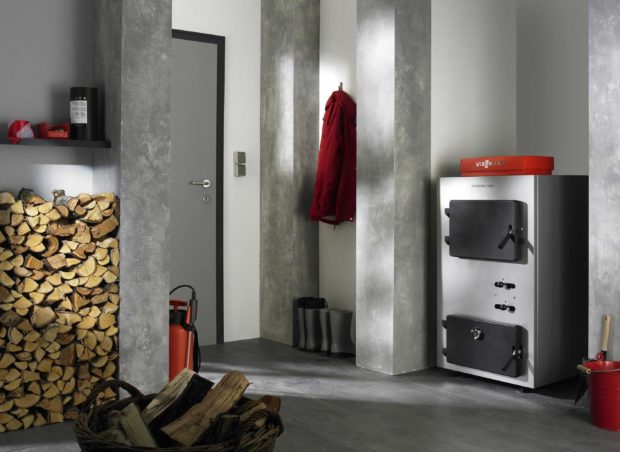

No. 10. Solid fuel boiler manufacturers
We will not open America if we say that quality largely depends on the reputation of the manufacturer. Large companies will not spoil their name with products of inadequate quality, so when choosing a solid fuel cat, it is better to pay attention to models from trusted manufacturers. This is the case when it is better not to save.
You can mark boilers of the following brands:
- Buderus - a German company that specializes in the production of boilers for various types and purposes. Solid fuel models run on different types of fuel, there are classic and pyrolysis boilers, the power is enough to heat large private houses;
- Bosch produces traditional non-volatile boilers;
- Ferroli Is a large Italian company that produces household and private boilers. Among the solid fuel boilers there are coal, wood and pellet boilers. The assortment is wide, the quality is high;
- SIME Is another Italian company that has made a name in just 35 years. Products are exported to 50 countries around the world, the range is represented by coal and wood-fired boilers;
- VIADRUS - Czech boilers. They are presented in a fairly wide range, reliable, safe, and have a pleasant cost;
- Stropuva Is a Lithuanian manufacturer that often introduces new solutions in the field. The latest development is a 40 kW boiler with the ability to work from one load for 30 hours;
- Protherm - high quality Slovak cast iron boilers with high efficiency.
You can also note the products of domestic enterprises produced under the brands "Prometheus" (for houses up to 450 m2), "Hearth" (there are double-circuit boilers), "Zota" and "Smoke".


Some subtleties in the design of boilers
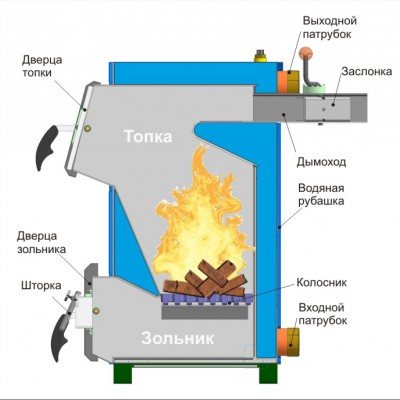

Solid fuel boiler device
First, let's take a look at how a classic boiler works. The standard apparatus consists of a loading hopper (furnace), an ash chamber and an ash pan for collecting ash, a grate, a water jacket, inlet and outlet pipes, a chimney and a damper. Also, the boiler device can include a fan and an automatic control unit.
Automation allows you to control the circulation pump of the heating system, as well as adjust the amount of air supply to control the fuel combustion process, depending on the selected temperature regime.
Fan control unit
Maximum efficiency in the best solid fuel boilers is achieved with a small excess of air and minimum heat losses along with the exhaust of flue gases.
For this, a regulator is built into the chimney, which mixes cold air into the chimney, allowing you to keep the maximum amount of heat inside the boiler furnace.
A cold chimney is evidence of a high-quality solid fuel boiler with a high efficiency.
In pyrolysis boilers, an automatic draft regulator is usually installed when the circuit is connected to the lower oxygen supply port. The required amount of air is supplied under the grate to ensure fuel combustion.
After the wood is on fire, the automatic chain regulator closes the lower window, eliminating excess oxygen supply to the combustion chamber. There are also boilers with manual adjustment, which allows you to increase or decrease the draft, according to the selected temperature regime.
Chain-link draft regulator
When considering pyrolysis boilers, pay attention to the presence of a secondary air supply regulator with an additional combustion chamber, as this allows additional combustion of CO2 gas, which is produced during the combustion of solid fuel, which in turn increases the boiler efficiency.
Additional combustion chamber
